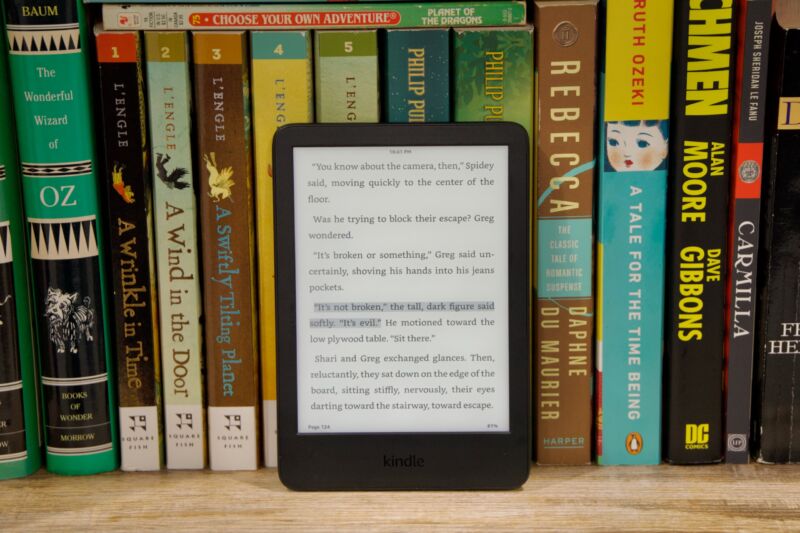
Enlarge / The new $100 Kindle is Amazon's best entry-level model ever, though it still has to live in the Paperwhite's shadow. (credit: Andrew Cunningham)
Amazon’s Kindle Scribe is the e-reader lineup’s exciting new high-end device, the one that's pushing the Kindle experience forward. But it’s just as important for Amazon to keep pushing the baseline forward for the people who want to hop into the ecosystem but don’t want to spend too much.
So we come to the new $100 Kindle (or $120, with no ads). Also called the “2022 release” or “Kindle (11th generation)” on Amazon’s product pages, this model costs $10 more than the one it replaces (inflation comes for us all), but it has new perks to help justify the price bump. For the first time, the basic Kindle has the same 300 PPI screen density as the rest of the lineup, and Amazon has streamlined the top and side bezels around the 6-inch screen to make the device smaller and lighter. USB-C, Bluetooth support for audiobooks, and a boosted 16GB of storage round out the spec sheet.
We’ve had the new Kindle for a few days, not long enough to read more than a few hundred pages or put a dent in the battery but long enough to develop some impressions about the device's strengths and weaknesses. The main question to answer: Who should buy this Kindle, and who should spend $40 more on the waterproofing and larger, nicer screen of the current Kindle Paperwhite?
Read 13 remaining paragraphs | Comments

Enlarge / The new $100 Kindle is Amazon's best entry-level model ever, though it still has to live in the Paperwhite's shadow. (credit: Andrew Cunningham)
Amazon’s Kindle Scribe is the e-reader lineup’s exciting new high-end device, the one that's pushing the Kindle experience forward. But it’s just as important for Amazon to keep pushing the baseline forward for the people who want to hop into the ecosystem but don’t want to spend too much.
So we come to the new $100 Kindle (or $120, with no ads). Also called the “2022 release” or “Kindle (11th generation)” on Amazon’s product pages, this model costs $10 more than the one it replaces (inflation comes for us all), but it has new perks to help justify the price bump. For the first time, the basic Kindle has the same 300 PPI screen density as the rest of the lineup, and Amazon has streamlined the top and side bezels around the 6-inch screen to make the device smaller and lighter. USB-C, Bluetooth support for audiobooks, and a boosted 16GB of storage round out the spec sheet.
We’ve had the new Kindle for a few days, not long enough to read more than a few hundred pages or put a dent in the battery but long enough to develop some impressions about the device's strengths and weaknesses. The main question to answer: Who should buy this Kindle, and who should spend $40 more on the waterproofing and larger, nicer screen of the current Kindle Paperwhite?
Read 13 remaining paragraphs | Comments
October 10, 2022 at 10:05PM

Post a Comment